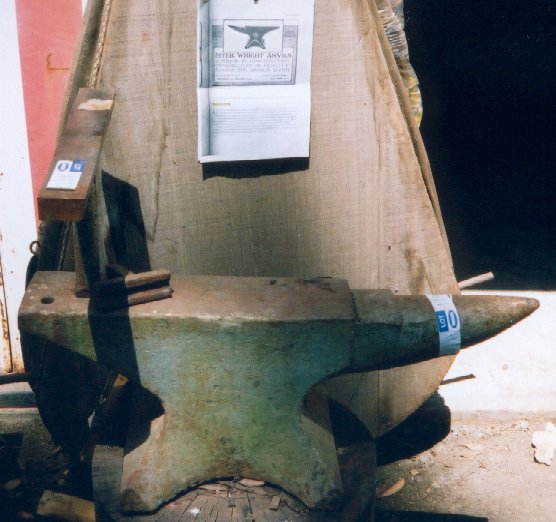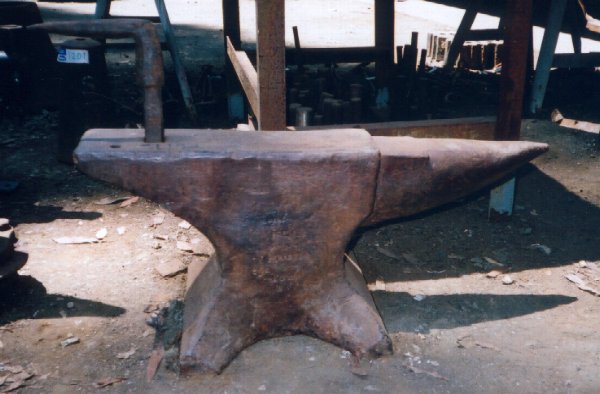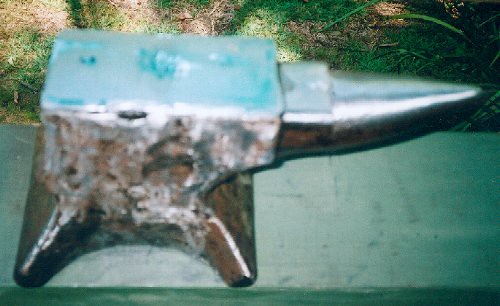 Thanks: 0
Thanks: 0
 Likes: 0
Likes: 0
 Needs Pictures: 0
Needs Pictures: 0
 Picture(s) thanks: 0
Picture(s) thanks: 0
Results 1 to 3 of 3
Thread: Anvils
-
26th Sep 2007, 05:44 PM #1
 Anvils
Anvils
After a few more laughs at the expense of anvil buyers on e-bay that pay 500, 600, and more for old worn out anvils that clearly need a lot of difficult repairs reserved only to the expert, I came across this article on anvils, worth a read. I discovered that I am not the only one thinking that most old anvils on e-bay, (with some honorable exceptions) are rubbish.
http://homepages.tig.com.au/~dispater/blacksmithgallery.htm
BUYING AN ANVIL As stated above, I don't recommend buying a second-hand anvil unless it is in good condition and cheap. More on good condition a little later. As far as cheap goes, that really depends on what you are buying. Don't fall for the old formula of $X per pound. It's nonsense, because you are buying a whole unit, not a quantity. It's also a con used by people who want to jack up the price of an old door stopper. Rounding off from $1.75 a pound to $2 a pound makes the math easier, but it's going to cost you $140 more for a 5 cwt anvil. Think about it. Also at prices like those, you could get a new Czech anvil and still have plenty of change. Avoid auctions if you can. It's always worthwhile and often enjoyable going to a pre-sale inspection, but waiting around all day waiting for your lot to come up is a waste of time, and deliberately calculated to work buyers into a frenzy. Not to mention having to come back at a specific time to collect your purchase. If it's worth it, leave an absentee bid for a fair price. The type of auctions that offer blacksmithing equipment these days are usually full of collectors of one sort or another. Auctioneers will often play up to them, and paste photocopies from collectors books or old tool catalogues near equipment to "prove" its collectors value. You can't have it both ways, either you are buying a collectors piece, or you are buying a tool. You can't make an "investment" and then literally chip away at its value by using it. Or you could, but then you'd either be stupid or rich enough not to care.
Avoid auctions if you can. It's always worthwhile and often enjoyable going to a pre-sale inspection, but waiting around all day waiting for your lot to come up is a waste of time, and deliberately calculated to work buyers into a frenzy. Not to mention having to come back at a specific time to collect your purchase. If it's worth it, leave an absentee bid for a fair price. The type of auctions that offer blacksmithing equipment these days are usually full of collectors of one sort or another. Auctioneers will often play up to them, and paste photocopies from collectors books or old tool catalogues near equipment to "prove" its collectors value. You can't have it both ways, either you are buying a collectors piece, or you are buying a tool. You can't make an "investment" and then literally chip away at its value by using it. Or you could, but then you'd either be stupid or rich enough not to care.
I have been to many auctions over the years and seen many disreputable shenanigans and even more stupid behaviour.
At one sale, a 140 lb cast anvil was up for grabs. There was some interest, but it was mainly a machinist's auction so I was hopeful. I gave it a few taps and it rang in an odd way. Luckily the anvil was in strong sunlight and my colleague pointed out something I missed. Every time I hit the anvil a tiny puff of dust spurted out from between the steel face and the body of the anvil – the face was coming loose. Despite this I bid $AUD90 on it, but before long the bidding went crazy and the winner walked off with the anvil but $AUD450 poorer.

At another sale, we turned up on a Sunday morning, only to find the auctioneer had changed the order of sale and excluded all the advertised (and desirable) lots in favours of a load of junk. After some angry words, he agreed to add a few smithing items as the climax of the sale. These included a mechanical hammer, two anvils, two swage blocks and some worn out blowers and tongs. Sure enough, the Peter Wright 280 lb anvil had some photocopies up next to it. Despite having had its entire face welded over with a stick welder (thin sheets of weld were flaking off) , and bad wear everywhere else it went for $1000 under the baleful influence of the auctioneers. The second anvil, a 336 lb unmarked model in even worse condition went for $900. The Classified ads have their own pitfalls. A lot of anvils come up for sale here when local taxes fall due. Invariably, upon calling up the seller will ask for $AUD500 (or more recently, $AUD1000 – since taxes have gone up). The seller often knows nothing about the anvil (brand, dimensions, weight), but will invariably claims they would rather not sell the anvil because it was in the family for a long time etc. When asked where they have it stored, the answer is invariably "out in the yard". I'm sure if you checked, it would still have mud on in from when the tractor dragged it out of the bottom paddock! Come on now, how much effort does it take to store a "valuable heirloom" under an oily feed bag in the barn or shed?
 Now lets talk about condition. Don't buy an anvil that isn't in one piece. Worn out anvils often appear for sale with such obvious signs of abuse as broken or bent horns and broken heels (often at the hardy hole where tapered tools have been forced in, splitting the metal like wood), or in the case of cast iron anvils with a steel face, a loose or missing face. Check to see that the anvil rings by tapping lightly with a small hammer (ask the owners permission first). With a steel anvil, this should be loud and clear, especially out on the heel. Cast iron anvils with a properly bonded steel face will ring too, but with a different harsher tone. If there is a poor ring then the face may be separating. If there s no ring, and your hammer blow leaves a dent, you are not dealing with an anvil, but a Chinese 100% cast iron door stopper, otherwise known as an Anvil Shaped Object(ASO). Do not, under any circumstances buy a cast iron "anvil" without a steel face, whether modern or antique. The ball-bearing bounce test is a useful method of identifying different types of anvil construction. You need a ball bearing of 12.5 mm or larger diameter, and a piece of clear, rigid plastic tubing about 50 cm long marked into ten divisions. Position over the anvil and drop the ball down the middle of the tube. The amount of rebound is relative to the hardness of the anvil face, and a good anvil will easily give over 80% rebound. Do the test a few times over the whole face, and average out for a total score. On a well-hardened anvil, the centre will usually be a little harder than the edges of the face.
Now lets talk about condition. Don't buy an anvil that isn't in one piece. Worn out anvils often appear for sale with such obvious signs of abuse as broken or bent horns and broken heels (often at the hardy hole where tapered tools have been forced in, splitting the metal like wood), or in the case of cast iron anvils with a steel face, a loose or missing face. Check to see that the anvil rings by tapping lightly with a small hammer (ask the owners permission first). With a steel anvil, this should be loud and clear, especially out on the heel. Cast iron anvils with a properly bonded steel face will ring too, but with a different harsher tone. If there is a poor ring then the face may be separating. If there s no ring, and your hammer blow leaves a dent, you are not dealing with an anvil, but a Chinese 100% cast iron door stopper, otherwise known as an Anvil Shaped Object(ASO). Do not, under any circumstances buy a cast iron "anvil" without a steel face, whether modern or antique. The ball-bearing bounce test is a useful method of identifying different types of anvil construction. You need a ball bearing of 12.5 mm or larger diameter, and a piece of clear, rigid plastic tubing about 50 cm long marked into ten divisions. Position over the anvil and drop the ball down the middle of the tube. The amount of rebound is relative to the hardness of the anvil face, and a good anvil will easily give over 80% rebound. Do the test a few times over the whole face, and average out for a total score. On a well-hardened anvil, the centre will usually be a little harder than the edges of the face.
Take a straight edge, small steel ruler and a small engineer's square along and check the face for wear. If an anvil is visibly worn out of true, you may be better avoiding it. Use the straight edge to measure how much you might have to grind/mill off the face to bring it back to true. Any more than 3.2 mm (1/8") may risk having to heat-treat the anvil again –not cheap – but a lot depends on the type of construction involved and the type of steel involved.
Measure the hardy hole –avoid anvils with odd-sized holes. Most hardies are 25mm (1") or 32 mm (1 ¼"). Sure, you can make your own hardy tools, but it helps if you can buy tool steel off the rack that's a precise fit. Check for chipped edges, even around the hardy hole. You will end up doing a lot of fine work on the surface around the hardy hole.
Check for repairs done with an arc welder. Unless the anvil was properly preheated, these may just break off first time they are hit. Also, the heat involved may have softened the face adjacent to the repair. On a solid steel anvil, the answer to that is to heat-treat the face from scratch. On cast iron and wrought anvils with steel faces, re-hardening risks cracking or loosening the face.
All of this said, if you are being given a free anvil, take it. You may or may not be able to fix it. With patience, hard work, and money all things are possible (even turning a cast iron boat anchor into an adequate anvil). If you are offered a scrap metal anvil for private sale, point out its faults and offer scrap metal prices to the owners. Most will knock you back and try to find another sucker - some may be reasonable and just want the thing out of the way quickly. If you are ready to start blacksmithing now, or intend to do blacksmithing as a paying profession, buy a new anvil.Civilized man is the only animal clever enough to manufacture its own food,
and the only animal stupid enough to eat it.
Barry Groves
-
26th Sep 2007, 08:17 PM #2

A very informative read. Thanks Marc!
Have a nice day - Cheers
-
28th Sep 2007, 06:38 PM #3

Yes the guy's tips are good.
One thing I disagree with him is about the "price per kilo" of an anvil.
It is not true that anvils are not sold by weight.
They are.
Here are two adds that state a price per pound:
http://www.anvilfire.com/wallace/used_equipment.php3
I bought my first anvil, a 40 kilo cast two horn anvil at a set price per kilo from the manufacturer. A 60 kilo of the same model would have cost almost 50% more. Simple.
Below, Kohlswa price list does not reflect one fixed price per kilo, agreed, yet the price within one model goes from 120 krons down to 80 krons per kilo as they get bigger. It is cheaper to make one 200 kilo anvil than 4x50 kilo one, yet the price is clearly in relation to the weight.
http://www.kohlswagjuteri.se/pdf/pricelist_anvils.pdfCivilized man is the only animal clever enough to manufacture its own food,
and the only animal stupid enough to eat it.
Barry Groves
Similar Threads
-
Anvils?
By Aerohydro in forum THE SMITHYReplies: 36Last Post: 11th Nov 2012, 11:16 PM






 Reply With Quote
Reply With Quote
